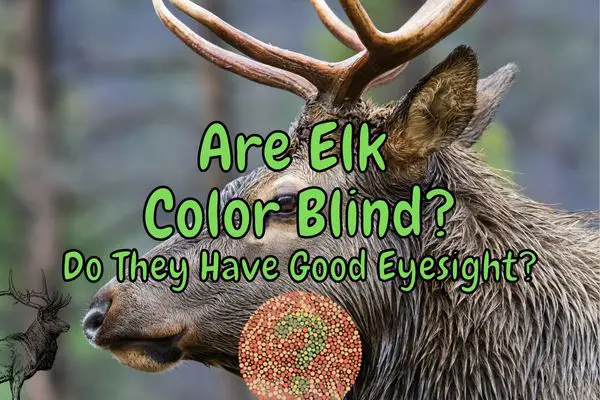Elk are known to have pretty fine-tuned senses and instincts which help them evade hunters and predators. Looking at an elk’s eyes, they are quite small, but size doesn’t necessarily dictate ability. When it comes to how elk see, are elk color blind?
Elk are technically not color blind, but they do not see color in the same manner as humans. Their vision is not just a sea of black, white, and gray, but they see a much more narrow color spectrum that enhances colors of green at the expense of the orange and red spectrum.
This means that some colors register for elk as they do for us and some colors don’t register at all.
Elk, deer and zebras as well as wild boar, rhinos, and giraffes belong to the mammalian clade of ungulates that also share the same type of vision.
There are also some colors that are harder for elk to interpret than others, with colors looking slightly different to elk than they do to other animals or humans.
On the other hand, when it comes to an elk’s eyesight, it is much better than a human’s in some aspects, but it is optimized for its herbivorous lifestyle as a plant eating prey animal!
Do Elk Have Good Eyesight?
An elk’s eyesight is superior to many other animals and their sight is good for what they need. Elk have quite adept night vision which serves them well when trying to evade harm from predators.
And like other ungulates, including deer that have almost identical vision to the elk, they can see more than a mile into the distance, which help them detect predators in time.
When compared to a human’s eyesight, while we can differentiate and interpret colors much better than elk do, their vision is overall much better than ours for their position as herbivorous prey animals.
Coupled with their other senses, the vision of elk is optimized for them to navigate their surroundings, find food and detect predators very well.
There is also limited research to suggest that ultraviolet and luminescence stand out much more prominently for elk, so reflective gear is not recommended when trying to hunt them.
If you wear orange, you’ll be spotted by others but elk won’t register the bright color.
They can see ultraviolet light with a much sharper eye due to their supreme ability to see shades of blue.
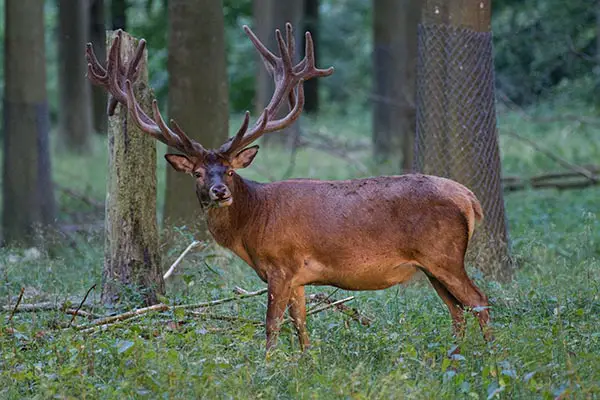
An elk’s field of vision and strength of vision is partially attributed to the location of its eyes. An elk’s eyes sit farther to the side of its head than they do for humans and most predatory animals.
This makes it so elk are able to see around to the sides with more clarity. When an elk turns its head just around 45 degrees to each side, they are able to see in a complete circle.
What Colors Do Elk See?
There are a few colors that elk are known to see based on scientific research. Since elk are what’s known as dichromatic animals, they are able to see yellows and blues. There are some colors that are more difficult for elk to see due to their eye structure.
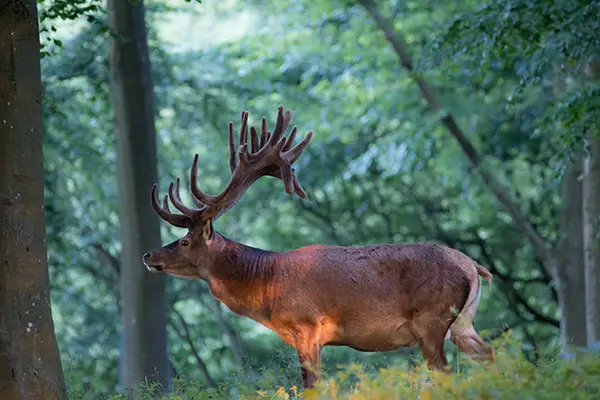
Elk do not have the appropriate apparatus in their eye to see colors on the red-green spectrum the same way that humans and other animals do.
Colors that fall within that spectrum will appear like a shade of gray to these animals. If those colors happen to have some blue or yellow, there’s a chance that those colors might be seen to a certain extent.
Can Elk See Orange?
Elk are not able to see orange and red the same way we see those colors. Colors in the orange range all appear much duller to elk, which allows hunters wearing “hunters orange” to blend in with their surroundings when seen through the eyes of an elk!
When an elk sees something that is orange, they are not going to interpret it as a brightly colored object as we humans do. When it comes to red, it doesn’t register as a color to elk at all.

Orange falls into the yellow-red spectrum of color that an elk’s eyes cannot see. As such, people tend to wear orange when hunting elk or exploring an area where elk live so as to try and blend in with the surroundings.
That said, depending on the shade of orange, if there is more yellow than red in it, an elk may be able to detect that what they’re looking at is in fact colorful and not gray.
What Color Is Hardest For Elk To See?
Red would be the most difficult color for elk to ascertain. Elk can technically see shades of red, but they don’t register as colors to them.
As such, they wouldn’t be able to differentiate red from gray. Any color that is a derivative of red can’t be seen by elk either.
Elk do not typically run into problems due to how they see color. Their other senses have been able to make up for what they lack in color differentiation in order to help them detect edible food and move through terrain with ease.
The only way their lack of ability to see all colors would impact them is when it doesn’t allow them to detect hunters.
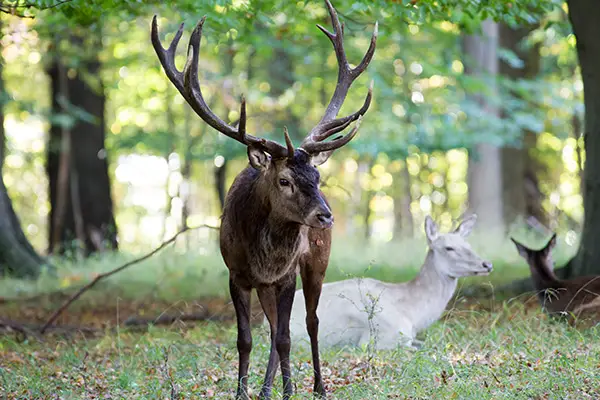
However, their other senses are likely to alert them to potential danger looming. Since elk are able to see at a much wider depth than humans can, there’s a good chance an elk will spot you at over a miles distance without you realizing they are looking at you!
If you’re not in their field of vision yet, there’s a high chance they’ll smell or hear you, so stealth is key.
Can Elk See In The Dark?
One of the most impressive things about elk eyesight is their ability to see in the dark. Elk are able to see quite well in low light conditions and even at night.
This is due to a number of reasons, one being that their pupils can open very wide. When it’s darker outside, our pupils open wider so that more light can enter our eyes and help us see better.
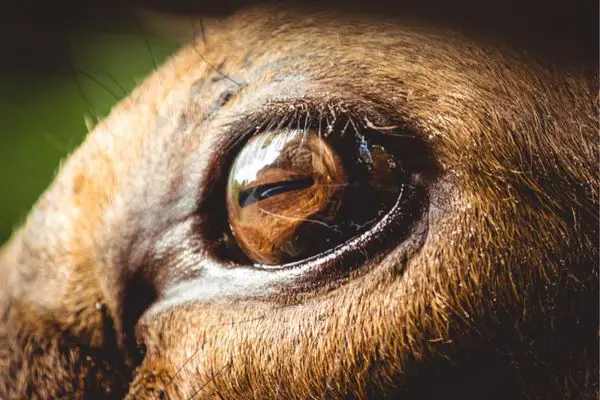
Elk have an adapted layer behind their retina known as the tapetum lucidum which helps them see better in low light conditions.
This layer reflects any available light back into the eye which gives them a second chance at seeing what’s around them.
The combination of these two adaptations makes it so elk have excellent night vision and can see quite well even when it’s very dark out.
Conclusion
Elk are not color blind, but they don’t see color in the same way that humans do. Their vision is not just a sea of black, white, and gray. However, elk do not see the wide spectrum of color, color variations, and shades like we do.
Some colors register for elk as they do for us and some colors don’t register at all.
The same is the case for senses like smell and hearing in many other animals such as wolfs, birds of prey, and even cephalopods like octopuses and squid that rely heavily on their eyesight!
Just like is the case for deer and other ungulates, there are also some colors that are harder for elk to interpret than others, with colors looking slightly different to elk than they do to other animals or humans.
On the other hand, when it comes to an elk’s eyesight for their role as a prey animal, it is much better than a human’s in most aspects, as they will always be on the lookout for apex predators.
Elk also have quite adept night vision which serves them well when trying to evade harm from predators like wolfs or mountain lions, or a black panther, lurking in the dark!
When compared to a human’s eyesight, while we can differentiate and interpret colors much better than elk do their vision can see exactly the colors they need to navigate the forests and avoid predators in an optimal way!

